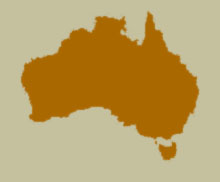Synonyms
Coccinella australasiae Boisduval, 1835: 593.
Orcus australasiae var. quadrinotatus Lea, 1902: 491.
Diagnosis
The presence of three maculae on each elytron in combination with the moderate size and strongly appendiculate tarsal claws distinguish this species from the other Australian Orcus.
Description
Length 4.0-5.6 mm. Male. Dorsal surface predominantly dark bluish, shiny; each elytron with 3 orange maculae; first abdominal ventrite usually dark brown; intermediates abdominal ventrites usually black medially and yellowish laterally; antennae, labial palp and last abdominal ventrite yellowish; rest blackish. Body rounded, convex. Head micro reticulate between punctures; punctation about as large as eye facets, shallow, nearly 1.5 to 2 diameters apart. Eyes with inner margin slightly diverging apically. Antenna 9-segmented; pedicel slightly longer than wider; 3rd antennomere slightly shorter than pedicel; 9th broad, slightly longer than basal width. Terminal maxillary palpomere with sides nearly parallel; the apex moderately oblique with outer side about 1.5 times as long as inner; terminal labial palpomere elongate; about 3 times longer than basal width; about as long as preceding segment. Pronotal surface sculptured as on head; punctation about as large as eye facets, as shallow as on head, approximately 1.5 to 2 diameters apart; the punctures not confluent on anterior angles, getting only slightly deeper and sparser; anterior angles without distinct strigae; lateral borders slightly truncate; bordering line uninterrupted at base, the line slightly opening anteriorly, slightly bent on lateral border; prosternum short in front of coxae, about as long as prosternal process widest width; hind tibiae with outer tooth; tarsal claws distinctly appendiculate. Elytral surface polished; punctation stronger than on pronotum, slightly deeper and more concentrated; lateral margin slightly reflexed, usually only on apical half, without clear bead; epipleural foveae absent. Abdomen with 6 ventrites; 6th fairly evident; surface of ventrite 1 polished between postcoxal lines; postcoxal lines joined at middle, shortly recurving apically; apical border of intercoxal process slightly swollen.
Male
Tegmen relatively long, about 2/3 the abdomen length; penis guide symmetrical, slightly longer than parameres; parameres sparsely setose, the setae short; strut as long as tegmen; penis identical to O. nummularis.
Female
Female externally similar to male, except for having only 5 visible abdominal ventrites, the 5th ventrite large and rounded, about 2 times longer than 4th.
Variation
Not observed.
 Distribution and Biology
Distribution and Biology
Very common species in southern and westernparts of Australia, including Tasmania. It has been found on various scales and observed feeding on casuarina mealybug, Pseudoripersia turgipes (Maskell).
Species References
Boisduval, J.B.A. 1835. Voyage de Découvertes de l'Astrolabe. Exécuté par ordre du Roi, Pendant les Années 1826-1827-1828-1829, sous le Commandement de M. J. Dumont d'Urville. Faune Entomologique de l'Océan Pacifique, avec l'illustration des Insectes Nouveaux Recueillis Pendant le voyage, Deuxième Partie. Coléoptères et autres ordres. J. Tastu, Paris, viii + 716 pp.
Lea, A. M. 1902. Descriptions of new species of Australian Coleoptera. Proceedings of the Linnean Society of New South Wales, 1901: 481-513.
Slipinski, S.A. 2007. Australian Ladybird Beetles (Coleoptera: Coccinellidae) their biology and classification. ABRS, Canberra. 286 pp.
Slipinski, A. and Giorgi, J.A. 2006. Revision of the Australian Coccinellidae (Coccinellidae). Part 6. Tribe Chilocorini. Annales Zoologici (Warszawa), 56(2): 265-304.
[ Top ]
